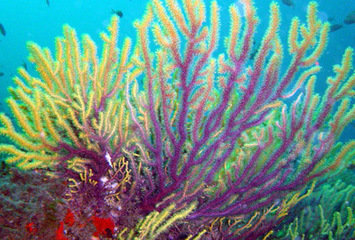PNAS:珊瑚与海洋酸化

澳大利亚西澳大利亚大学地球与环境系一项研究提示,某些珊瑚可能具有自带的保护措施,抵抗人类诱导产生的二氧化碳驱动的海洋化学变化。当大气二氧化碳(CO2)浓度增加的时候,一些二氧化碳溶解在海洋表面并降低了它的pH值,这种化学效应通常被称为海洋酸化。许多研究已经提示,未来的酸化可能严重威胁珊瑚等海洋生物,这些生物需要一个相对较窄的pH值范围从而制造它们的碳酸钙骨骼。Lucy georgiou及其同事研究了澳大利亚大堡礁Heron岛的研究地点的细柱滨珊瑚(Porites cylindrica)对海洋酸化的恢复力,他们使用了一种实验技术,模拟了未来二氧化碳驱动的pH值降低,同时允许这些生物保留在它的自然环境中。这组作者发现,细柱滨珊瑚(Porites cylindrica)在接近恒定的pH值下维持了一种“钙化液”的内部储存,因此可以让它的骨骼以同样的速率生长,而不管周围海水的pH值的变化。这种适应很可能是对Heron岛周围的非典型环境的一种应答,在这个岛,海水温度和pH值的涨落远远超过许多珊瑚系统。这组作者说,这些发现提示,目前在高度动态的环境中繁盛生长的珊瑚可能对海洋酸化具有恢复力。
原文链接:
pH homeostasis during coral calcification in a free ocean CO2 enrichment (FOCE) experiment, Heron Island reef flat, Great Barrier Reef
原文摘要:
Geochemical analyses (δ11B and Sr/Ca) are reported for the coral Porites cylindrica grown within a free ocean carbon enrichment (FOCE) experiment, conducted on the Heron Island reef flat (Great Barrier Reef) for a 6-mo period from June to early December 2010. The FOCE experiment was designed to simulate the effects of CO2-driven acidification predicted to occur by the end of this century (scenario RCP4.5) while simultaneously maintaining the exposure of corals to natural variations in their environment under in situ conditions. Analyses of skeletal growth (measured from extension rates and skeletal density) showed no systematic differences between low-pH FOCE treatments (ΔpH = ∼−0.05 to −0.25 units below ambient) and present day controls (ΔpH = 0) for calcification rates or the pH of the calcifying fluid (pHcf); the latter was derived from boron isotopic compositions (δ11B) of the coral skeleton. Furthermore, individual nubbins exhibited near constant δ11B compositions along their primary apical growth axes (±0.02 pHcf units) regardless of the season or treatment. Thus, under the highly dynamic conditions of the Heron Island reef flat, P. cylindrica up-regulated the pH of its calcifying fluid (pHcf ∼8.4–8.6), with each nubbin having near-constant pHcf values independent of the large natural seasonal fluctuations of the reef flat waters (pH ∼7.7 to ∼8.3) or the superimposed FOCE treatments. This newly discovered phenomenon of pH homeostasis during calcification indicates that coral living in highly dynamic environments exert strong physiological controls on the carbonate chemistry of their calcifying fluid, implying a high degree of resilience to ocean acidification within the investigated ranges.
doi: 10.1073/PNAS.1505586112
作者:Lucy Georgiou

